Nausicaa of the Valley of the Wind
Kaze no tani no Nausicaa
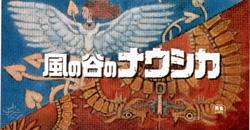
Prologue
About two minutes into the film just before the credits (which are run against the backdop of an important woven tapestry), these lines appear on the screen:
1000 years after the collapse of a giant industrial civilization,
rust and ceramic fragments covered the land. Over this wasteland,
a deadly forest of fungi that released poisonous vapors (miasmas),
which came to be called the "Fukai" (腐海, The Spoiled or Decayed Sea), spread and
it threatened the very existence of the declining human race.
The world is in a post-apocalytic state some one
thousand years after the legendary Seven Days of Fire, when the earth
was all but destroyed by humans, their technology, and war. In particular, God
Soldiers were deployed, mammoth, humanoid looking beasts that shoot off
huge, destructive explosives--with results that are much like nuclear explosions! The earth
is now covered by a dense forest, The Fukai (腐海), where a fungus, whose spores
are deadly to humans, thrives. The earth is also overrun with insects, especially
large menacing ones called Ohmu.
I like the way the manga version includes a longer Prologue, all in CAPS:
IN A FEW SHORT CENTURIES, INDUSTRIAL CIVILIZATION HAD SPREAD FROM THE WESTERN FRINGES OF EURASIA TO SPRAWL ACROSS THE FACE OF THE PLANET--PLUNDERING THE SOIL OF ITS RICHES, FOULING THE AIR, AND REMOLDING LIFE FORMS AT WILL.
JUST A THOUSAND YEARS AFTER ITS FOUNDATION, THIS GARGANTUAN INDUSTRIAL SOCIETY HAD ALREADY PEAKED; AHEAD LAY ABRUPT AND VIOLENT DECLINE.
THE CITIES BURNED, WELLING UP AS CLOUDS OF POISON IN THE WAR REMEMBERED AS "THE SEVEN DAYS OF FIRE."
THE COMPLEX AND SOPHISTICATED TECHNOLOGICAL SUPERSTRUCTURE WAS LOST, AND ALMOST ALL THE SURFACE OF THE EARTH WAS TRANSFORMED INTO A STERILE WASTELAND.
INDUSTRIAL CIVILIZATION WAS NEVER REBUILT AS MANKIND LIVED ON THROUGH THE LONG TWILIGHT YEARS...
ONCE FLOURISHING SOCIETIES DISAPPEARED INTO THE DARKNESS...
AND THE LAND WAS OVERTAKEN BY A FOREST OF COLOSSAL TOXIC BACTERIA: THE SEA OF CORRUPTION (腐海).
MANKIND FLED TO ITS PERIPHERY, FORMING KINGDOMS SCATTERED ALONG THE BITS OF LAND THAT REMAINED.
PROTECTED BY THE OCEAN WINDS,
BARELY ESCAPING POLLUTION FROM THE SEA
LAY A SMALL KINGDOM OF JUST FIVE HUNDRED KNOWN AS
--THE VALLEY OF THE WIND.
That is where our heroine, Princess Nausicaa--daughter of the ailing Lord
Jhil who suffers from the disease spread by the fungi--dwells.
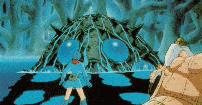
She has amazing empathy for these
great insects and she is dedicated to finding a way for all life forms on the planet to live
together and survive.
She has "mysterious" powers that enable her
to communicate with and calm the Ohmu when they are angry. When they are angry, there many eyes turn red and, as the old woman says, "The anger of the Ohmu is the anger of the earth!" When they are calmed down--when their "attack color" dissipates--their eyes revert to their normal blue color.
Here she is with her pet fox-squirrel, Teto:
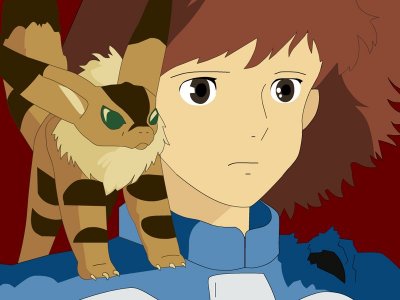
She and her followers live in a valley where the steady wind
keeps their air pure. They don't have to wear the protective masks that they
must when they travel outside the valley, and they live a very "green"
life there with windmills, clean water and a life in balance with the ecosystem.
But other human communities consider themselves at war with each other and with
the insects. Can humans live in the same world with insects? Nausicaa is told as a child that they cannot.
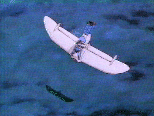
Nausicaa is adept at flying her Mehve [the German word for Seagull?] because she can read the
winds so well, and early
in the film, is delighted to be reunited with her "Sensei," Lord Yupa
(Yupa-sama), one of the greatest swordsmen in the land.

Lord Yupa is destined to wander the land in search of a solution
to keep the Fukai, the Wasteland, from encroaching on and endangering human
communities. This also happens to be something that Nausicaa is working on in secret,
as she grows plants from spores in her secret underground room which serves as her research laboratory. There, she has successfully developed plants that are
not poisonous, concluding that it is the soil which has been poisoned by humans
for thousands of years and that is the source of the problem.
Generally, Nausicaa's appearance conforms to that typical of
shôjo (young girl) of manga or anime (you
can see a related webpage by clicking on shojo), but there are some important
differences. Nausicaa is not overly "kawaii," or "cute," either
in appearance or behavior. She is strong, decisive and very capable. She is
completely empathetic with insects, animals and humans; and she is an effective leader of her community, the Valley of the Wind, despite her youth and her gender. The Ohmu, check her out with their antennae and can learn all about her past and judge her character. They see that she has a good heart.
There is also an old blind woman in the valley, O-Baba, who recounts
the legend of the valley people, and there is that tapestry that we see during the credits, which contains illustrations
of her story and a prophecy that goes along with it.
These old tales speak of a savior, "a person
clad in blue standing in a golden field who will find the bond between humanity
and the earth, and lead the people to a pure land."
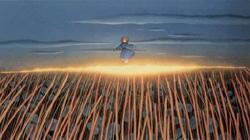
This is something to keep our eye on when we reach the end of the film.
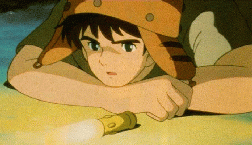
There is also a young Prince Asbel from the kingdom of Pejite,
a kingdom besieged by Torumekian (Tolmekian) warriors under the leadership of Princess Kushana
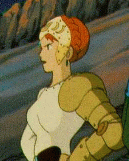
who wants to resuscitate the
embryo of a God Soldier/Warrior--the horrible killing machines unleashed
during the Seven Days of Fire--and to use it 1) Burn the entire Fukai, 2) Destroy the insects (Ohmu), and 3) restore Humanity to its former "glory."
She is
assisted by a ambitious, villainous but pragmatic character, Kurotawa.
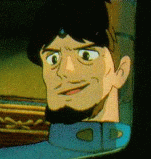
One of the most interesting points in the film is when Nausicaa
and Asbel sink in quicksand and fall through to another layer beneath the Wasteland
floor. Here, Nausicaa discovers fossilized trees that crumble into a sandlike
consistency, producing a layer of sand which then acts as a filter to purify
the water.
So, Eureka! This is the answer to the question Nausicaa has been
seeking: what gave birth to the Wasteland?
It turns out that it's not there
to threaten or consume humankind; it is there to save humans by purifying the water
and cleansing the soil so that new life can grow.
We see evidence of this in the
final frame of the movie. Then, we realize that the Ohmu are not evil enemies
of people but are there to protect the Wasteland which can, in turn, save, or
restore humankind. But can the warlike Torumekians like Lady Kushana ever be convinced of this? Or are they determined to to follow through with plans to destroy everything and start the world over again?
There's much more to the story but. . .well, you'll just have
to watch it and learn!
See also some useful links:
http://commentarytrack.com/2009/03/14/review-nausicaa-of-the-valley-of-the-wind-1984/
See an interpretive article here or look in the Resources section on Wise.
And another review:
Nausicaa of the Valley of Wind
(Kaze no Tani no Naushika)
(1984)
Written and directed by Hayao Miyazaki.
Based on the graphic novel by Miyazaki.
Running time: 116 minutes.
January 8, 2004
Nausicaa of the Valley of Wind is one of the true landmarks of animated cinema. Twenty years after its release, in a time when animation evolves by leaps and bounds, it continues to offer challenging ideas and genuinely move audiences. In Japan, Nausicaa routinely places at the top, or near the top, of every poll of the best anime films (it spent ten years at the top of Animage magazine's readers' polls, for instance). Here is a science-fiction adventure with ideas, with vision and heart.
Hayao Miyazaki made a name for himself animating and directing various movies and TV shows during the late 1960s and ‘70s, including popular shows such as Future Boy Conan and Lupin the Third. After directing his first feature film, 1979’s Castle of Cagliostro, and without any studio projects, he directed his energies on an original manga (graphic novel) saga. In 1982, Nausicaa of the Valley of Wind appeared as a monthly serial in Animage, and quickly proved so popular that demand arose for a movie. After early resistance, Miyazaki relented, on the condition that he direct the picture, and his longtime colleague Isao Takahata produce. They enlisted Topcraft Studios (best known for the Rankin-Bass version of The Hobbit), hired a skilled musician named Joe Hisaishi to compose the score, and released the film to theaters in 1984.
Based on a 12th Century Japanese folk tale (“The Princess Who Loved Insects”), Nausicaa of the Valley of Wind is set in a post-apocalyptic world where humans struggle to live amongst poisonous fungus forests, mutant insects, and herds of giant blue-eyed slugs called Ohmu. The heroine, Nausicaa, is a chieftain’s daughter, lives in a small nation in a protected valley, and shares an empathic bond with the insects of her world; she firmly believes that humans and insects can peacefully coexist, despite the ever-present threat of the growing forests. She’s the archetype of the Miyazaki heroine: strong-willed, confident, and full of spirit.
The Valley of Wind suddenly finds itself in the middle of a war between two warring nations, Torumekia and Pejitei. The combatants disrupt the relative peace of the Valley and start shoving their weight around. A God-Warrior, the ancient weapons responsible for the destruction of civilization, is unearthed. Both sides vow not only to defeat their enemy, but to burn back the forests and reclaim nature. This sets the stage for a number of action set-pieces (including some terrific aerial combat scenes), moments of quiet introspection, a fair amount of light humor, and a search (by Nausicaa) to solve the mystery of the mutated environment.
All the great hallmarks of Miyazaki are present in full: self-confident female characters, concern for the environment, solid compositions, an optimistic humanism, and lots of flying. When you look at the history of animated movies, you realize how groundbreaking Nausicaa really is. There are no song-and-dance numbers, no wise-cracking animal sidekicks, no simple-minded moral lesson for the kiddies, nothing in the traditional Disney mold. Yet, this also is not some juvenile adolescent sex fantasy ala Ralph Bakshi or Heavy Metal. Nor is this a clone of Star Wars or JRR Tolkein. This is a new style of animated film, opening the doors for movies like Waking Life and Millennium Actress and Whisper of the Heart and Princess Mononoke.
Howard Hawkes once claimed that a good movie should have three great scenes and no bad ones, and Nausicaa has the pick of the litter.
1. The first such scene is a wonderfully stylish flashback sequence involving Nausicaa as a young girl. The flashback is drawn in a hypnotic, slightly surreal movement of rough pencil sketches and minor watercolor touches. The child tries in vain to protect a baby Ohmu from faceless adults (including, importantly, her father), only to lose her pet in a swarm of clawing hands, and it’s a great moment; all those swaying hands remind me of the “Tower of Babel” sequence in Fritz Lang’s Metropolis.
2. The second great scene is a tribute to something usually overlooked in animation: the acting. It’s the moment when Nausicaa tries to rescue a young Ohmu, which has been deliberately injured in order to trigger a deadly stampede. The giant insect sees the herd on the opposite side of an acid lake and starts crawling towards them. Nausicaa struggles to hold the Ohmu back, but her leg is pushed into the lake; she screams. The actress, Sumi Shimamoto (who also appeared in Castle of Cagliostro, My Neighbor Totoro and Princess Mononoke), belts out a sustained scream that chills to the bone. It’s one of those great acting moments that fans often recall in hushed tones.
3. The third great scene occurs thirty minutes into the picture. The Valley of Wind is invaded by the Tolmekian army, and something happens. I won’t reveal what, but this incident drives Nausicaa into a fury. She grabs a weapon, yells out, and kills several guards before she is subdued. It is a sudden and violent moment; this scene is shocking, and it sears into your mind. She doesn’t merely kill the soldiers, she cuts them down with strenght, purpose and viciouness.
Is this the most important scene in the film? Without it, the movie doesn’t work; it would be little more than a preachy environmental parable (“man and nature can get along”). With it, the movie suddenly becomes much more complicated, nuanced. If the hero were male, this would be an expected cliché; almost a rite of passage. How many American films see violence as the answer to all questions? The gun is usually a substitute for the questions themselves.
When you put an intelligent, almost pacifist heroine in the role, the meaning changes. This girl is just as capable, deep down, of the same impulses that drive her adversaries to kill. She’s no longer just a pure Gandhi figure who always chooses right. Nausicaa is an animated film that firmly attacks gender stereotypes. Notice how the heroine avoids the traditional Disney cliché of the helpless princess who waits to be rescued by her prince. Notice also how she avoids the anime and action movie cliché (think Charlie’s Angels) of the superbabe who kicks ass and coolly dispatches tired one-liners.
The more I watch this film, the more aware I become of how effectively Miyazaki blurs these distinctions, to create characters who are more complex and emotionally honest. Kushana, the leader of the Torumekian army, is likewise not a typical cartoon villain, but a sympathetic character. When she casually reveals that she has lost her arm to insects (and possibly both her legs), you understand why she wants to burn the forests. There are also hints of conflict with her superiors back home, if you pay close attention. There are questions raised that are not necessarily resolved.
A lot of this is because the movie was based on an ongoing comic, which had just finished two volumes. Miyazaki is still working with some of the characters, wrestling with their motivations. The manga was still a handful of open threads; the screenplay does a terrific job of streamlining everything into a two-hour movie, while still showing echoes of greater events and themes to come.
Miyazaki would spend the next ten years, between movies, writing the manga; when he finally finished in 1994, he had written seven volumes and nealy 1100 pages. The scope of the story grows far beyond the boundaries of the movie, and grapples with the deepest themes of literature. The finished Nausicaa epic is one of the greatest novels I’ve ever read, and still, the elements of that story -- the blurred lines, the pathos, the action, the characters – are visible in the 1984 film. Maybe not as vividly, but everything’s there. Notice, also, how nearly all the original events in the movie are recycled back into the novel at various points, especially in the final volume.
This is what draws me back time and again. I enjoy the movie for what it achieved, for the barriers broken, for the way all the various versions (film, novel, Mononoke) intersect. Even its flaws are compelling. That ending is practically the definition of deus ex machina, but when it works so well, does it really matter? Does it matter that later anime like Akira or Ninja Scroll have smoother animation? Those movies are cold-hearted, mean bastards. This movie pulses with life.
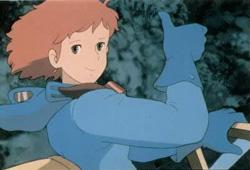
Thumbs up to you, too, Nausicaa!!










